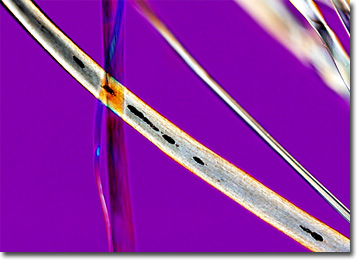Polarized Light Microscopy Digital Image Gallery
Camel Down
Geological evidence suggests that camels originated in North America approximately 40 million years ago and later migrated to South America and Asia, a surprising fact since camels are more commonly associated with expansive desert landscapes, rather than the United States and Canada. The animals are generally believed to have vanished from their native continent sometime after the glacial period.

Camels are most widely recognized by the characteristic fat-storing humps they carry on their backs. These humps may occur in pairs or singly depending on species. The Arabian camel, also known as the dromedary, is a one-humped variety that has a lighter build and a shorter coat than the double-humped Bactrian camel. The dromedary can travel at greater speeds than its counterpart, but the Bactrian can typically withstand heavier weights. Both species have been domesticated for extensive amounts of time and are primarily utilized as beasts of burden, though they also are kept for meat, milk, and wool production.
The Bactrian camel is the variety most commonly raised for its coat, which is comprised of an outer layer of long, coarse guard hairs and a much finer, short layer of underfur, frequently referred to as down. Unlike most other animals, the coat of the camel is not usually sheared or plucked. Instead, camel hair is typically gathered by hand when the animal sheds its coat in the spring. The down is then generally separated from guard hairs through mechanical processes, and both types of fiber are prepared for use. Coarse camel hair is quite strong and is most in demand for industrial textile items such as press cloths and machine belts. In contrast, camel down is relatively soft and is primarily utilized for overcoats, knitwear, and bedding. The material is also much lighter than wool and quite durable, in addition to being an excellent insulator.
